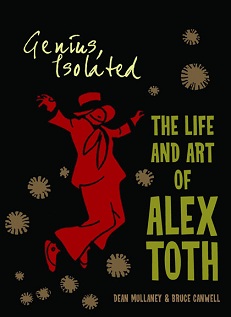
Genius, Isolated: The Life and Art of Alex Toth
Dean Mullaney & Bruce Canwell
324 pages
published in 2011
If you're not a hardcore comics nerd you've probably never heard of Alex Toth, one of the greatest cartooning geniuses American comics have ever seen. That's because he never really had a comics series or character that he made his own, but instead had his art scattered over hundreds of seperate assignments for dozens of publishers, often wasted on formulaic, throwaway stories. His true genius lay in his approach to the art form, the way he stripped down cartooning to its essentials, never putting down one more line than was needed. Once you see his artwork you can understand why he's so revered by his peers, a true "artists' artist", but first you needed to find his artwork, which has long been difficult to find other than by hunting through back issue bins.
This has changed in the last decade or so, fortunately, as the American comics field in general has become more aware and interested in its heritage, leading to a flood of high quality reprint projects as well as art books/biographies focusing on individual artists. Toth has had some attention paid to him before, but with Genius, Isolated: The Life and Art of Alex Toth, the first of a trilogy of books devoted to Toth's life and career there finally is a book that does true justice to Toth's genius.
It does so by being more than just a lavishly produced, gorgeous looking coffee table book and biography but also a showcase for Toth's artwork. As many or more pages are devoted to reproducing Toth's art, including a huge selection of complete stories as there are to talking about his art; there are only a few pages entirely devoid of his artwork. It's this that makes Genius, Isolated such an important book, a demonstration of Toth's artistic genius as well as an archive of stories that haven't been seen since their first publication decades ago. Such showcases are important to establish an artist's reputation, as they provide both a convenient sampler for people new to them, as well as a signal that yes, this artist is important enough to merit a fifty dollar art book.
There is a downside to publishing so many complete stories in this book, as I explained a few days ago at Wis[s]e Words, which is that you can't help but notice how many of the stories Toth did his best work on were, to be honest, not nearly as well written as Toth illustrated them. If, like me, you tend to focus more on the story than the art when reading comics, it can be a handicap in appreciating Toth's work.
Fortunately Toth's art is strong enough to overcome this handicap; you can't help but fall in love with it. What characterises it is his use of strong, angular lines to sketch his figures, the use of black shapes, silhouettes and shadow both to create mood and to compose his pages and panels, the economical way in which he conveys emotion with just a few lines and how he places his characters to guide your eye over the pages. Composition is the key word with Toth; at each level -- panel, page, story -- he excels in creating a holistic experience and make it look natural. Apart from that, his artwork at his best is drop dead gorgeous, the kind of art that leaves you staring at it open mouthed in sheer admiration.
The text that goes along with Toth's artwork concentrates on the artist's life and career, providing a decent biography, though not really much more than that. It's good enough as it goes, but I would've liked to see more discussion of Toth's art and how he created it. There is some of that, but not enough for my liking. Hopefully we'll see more of that in the next two volumes in the series.
Webpage created 24-03-2012, last updated 24-03-2012.